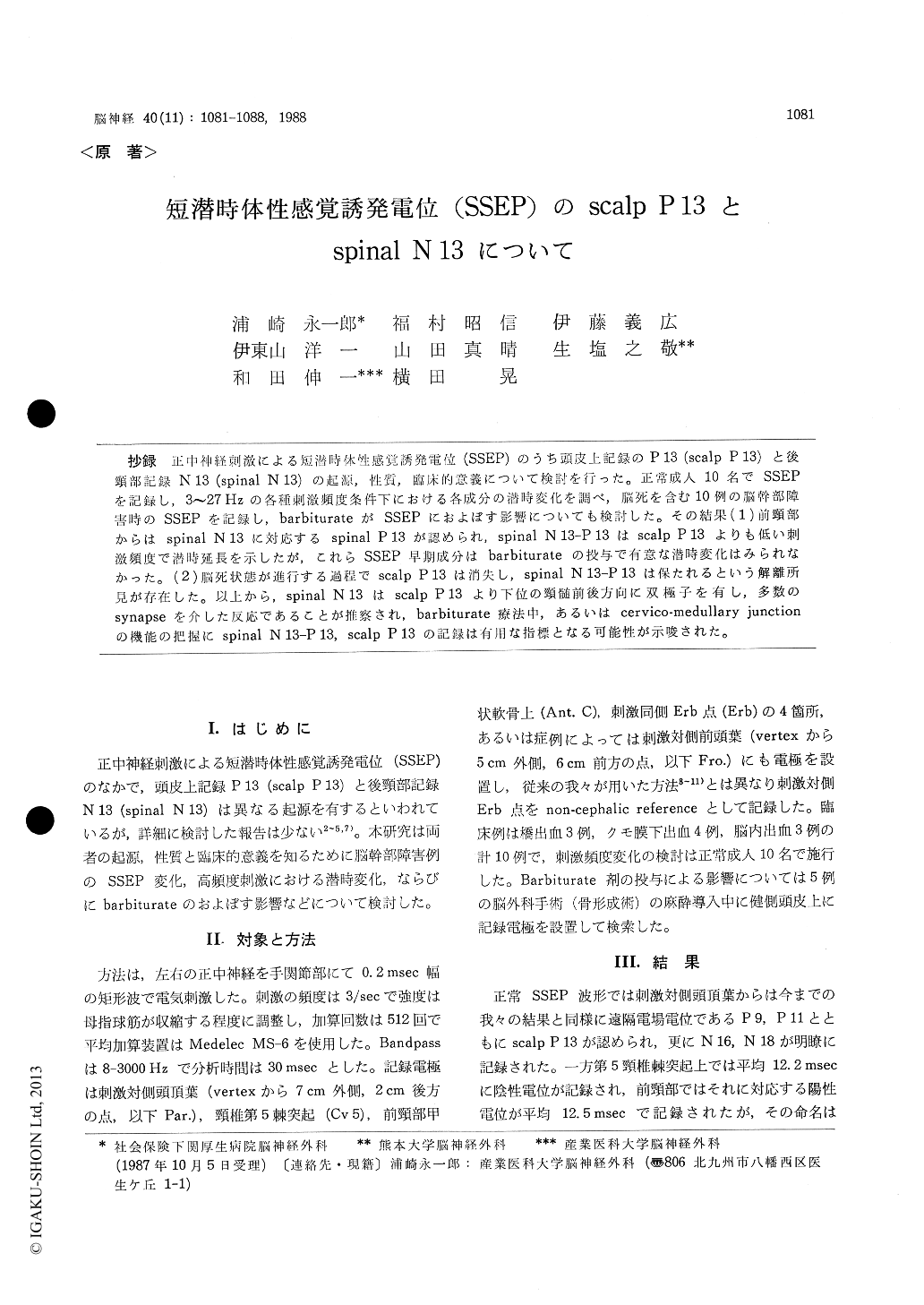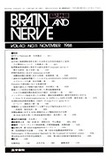Japanese
English
- 有料閲覧
- Abstract 文献概要
- 1ページ目 Look Inside
抄録 正中神経刺激による短潜時体性感覚誘発電位(SSEP)のうち頭皮上記録のP13(scalp P 13)と後頸部記録N13(spinal N 13)の起源,性質,臨床的意義について検討を行った。正常成人10名でSSEPを記録し,3〜27Hzの各種刺激頻度条件下における各成分の潜時変化を調べ,脳死を含む10例の脳幹部障害時のSSEPを記録し,barbiturateがSSEPにおよぼす影響についても検討した。その結果(1)前頸部からはspinal N 13に対応するspinal P 13が認められ,spinal N 13-P 13はscalp P13よりも低い刺激頻度で潜時延長を示したが,これらSSEP早期成分はbarbiturateの投与で有意な潜時変化はみられなかった。(2)脳死状態が進行する過程でscalp P 13は消失し,spinal N 13—P 13は保たれるという解離所見が存在した。以上から,spinal N 13はscalp P 13より下位の頸髄前後方向に双極子を有し,多数のsynapseを介した反応であることが推察され,barbiturate療法中,あるいはcervico-medullary junctionの機能の把握にspinal N 13—P 13, scalp P 13の記録は有用な指標となる可能性が示唆された。
Using non-cephalic reference and by median nerve stimulation, P 13 component and N 13 com-ponent are recorded on the scalp (scalp P 13) and the posterior neck (spinal N 13), respectively, in the short latency somatosensory evoked potentials (SSEP). The purpose of this study is to disclose the origin, characteristics and clinical significance of these two components.
Ten healthy volunteers served for normal sub-jects. Ten patients with pontine lesion or brain death were studied. The effect of barbiturate was also studied in additional 5 patients during anes-thesia for cranioplastic surgeries. Electrical stimuli of 0. 2 msec square wave pulse were used in rou-tine examination. To confirm the effects of stim-ulation frequency, 3, 6, 9, 12, 15, 18, 21, 24 and 27 Hz were also used in normal subjects. Record-ing electrodes were placed in the following sites. ( 1) Scalp electrode at the Shagass' point con-tralateral to the stimulated side (Par.). ( 2 ) Pos-terior neck electrode on the spinous process of the fifth cervical vertebrae (Cv 5) , ( 3 ) Anterior neck electrode on the thyroidal cartilage (Ant. C). ( 4) Erb's electrode just above the mid-clavicular point ipsilateral to the stimulation. Erb's electrode contra-lateral side of stimulation was used as a reference.
Spinal N 13 on posterior neck reversed its po-larity into P 13 (spinal P 13) on the anterior cervical electrode. A study with different stimulus rates revealed that the latency of scalp P 13 sig-nificantly prolonged at 24 Hz stimulation. On the other hand, the latency of spinal N 13-P 13 easily prolonged even at 18 Hz. This suggested that spinal N 13-P 13 were generated polysynaptically. Clinical doses of barbiturate (thiopental sodium 5~10 mg/kg) did not affect on the latency of both scalp P 13 and spinal N 13-P 13 components. Clin-ical study demonstrated that scalp P 13 and spinal N 13-P 13 were clearly recorded in the patients with pontine lesion, however, the dissociation be-tween scalp P 13 and spinal N 13-P 13 were seen in the patient of brain death ; i. e., the absence of scalp P 13 and the presence of spinal N 13-P 13. In conclusion, the present study suggested that spinal N 13-P 13 reflected the activity interposed by many synaptic events in the cervical cord, probably of dorsal horn origin, while scalp P 13 reflected the activity of cervico medullary junction. Scalp P 13 and spinal N 13-P 13 are useful in monitoring the function of cervico-medullary junc-tion and cervical cord, respectively, during the barbiturate therapy and in the diagnosing the brain death.

Copyright © 1988, Igaku-Shoin Ltd. All rights reserved.


